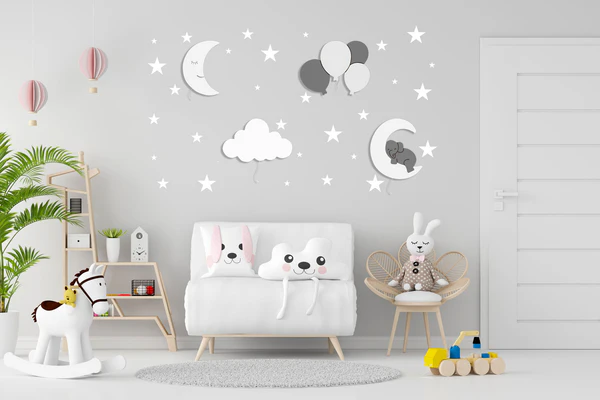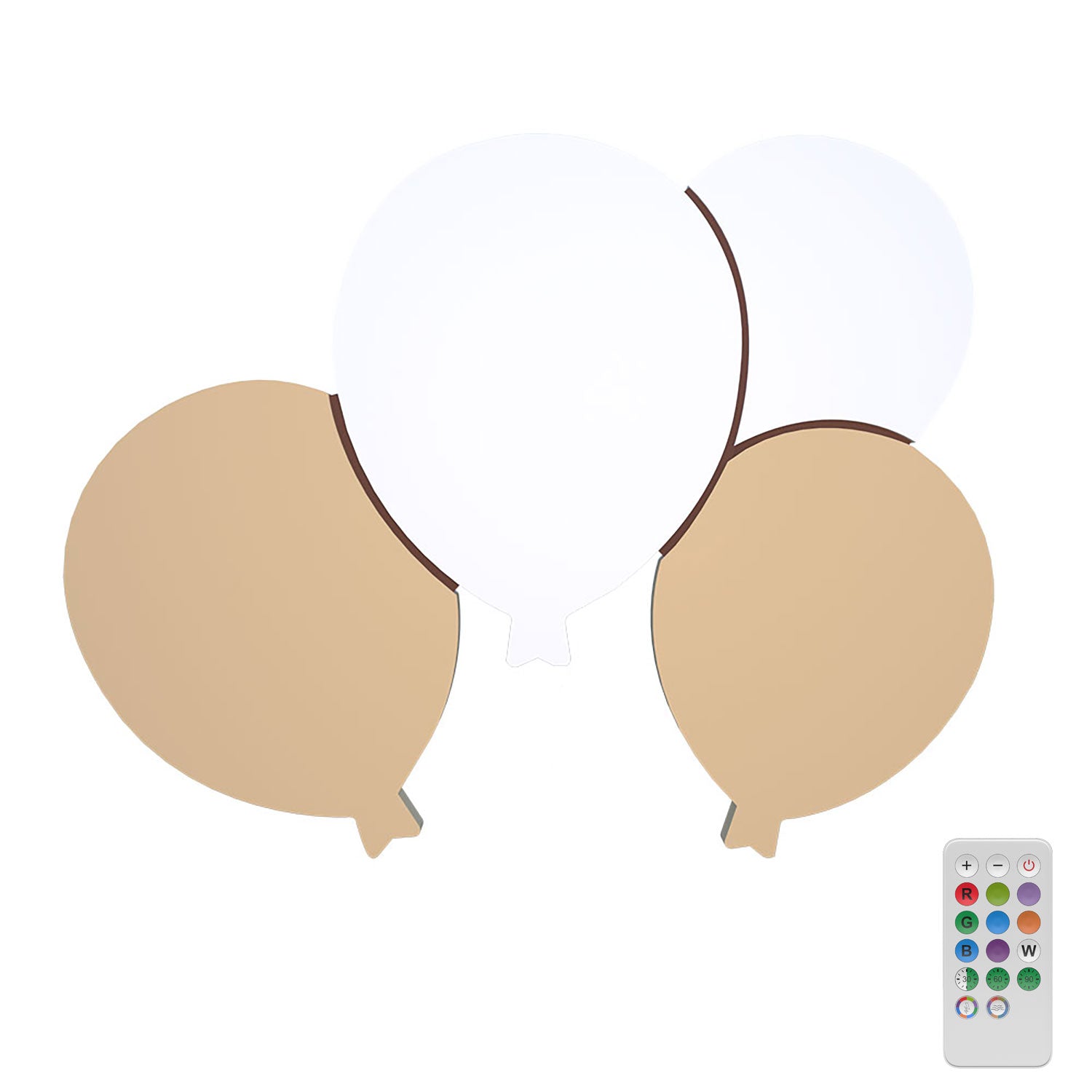Creating a nursery that is both stimulating and calming can greatly contribute to your baby's well-being and sleep. To achieve this, it is essential to adopt appropriate strategies in terms of decoration, layout and atmosphere.
Together we will explore how small adjustments in these areas can transform your child's space into a harmonious and restful place. By doing this, you will provide your baby with an environment that promotes deep, restful sleep, while encouraging their development.
Create a calming baby room: Decorating tips
To create a decoration calming, it is essential to keep it simple, especially if your baby is very curious. Avoid placing visually stimulating objects near the crib or bed, as they may distract your child and delay falling asleep. Additionally, it is best not to put stuffed animals or toys in the bed for safety reasons and to avoid distractions.
Colors play an important role in the ambiance of the bedroom. Pastel shades, like blue and purple, are ideal for promoting calm and softness. Beige offers a feeling of stability, while gray, often perceived as cold, should be used sparingly. Yellow can bring a touch of brightness to less lit rooms, and pink adds a note of tenderness and joy. Finally, green evokes nature and calm, and can be an excellent option for a serene atmosphere.
At the planning level
Side development, to create a true haven of peace in your baby's room, it is crucial to keep the space tidy. A well-ordered environment contributes to a relaxing atmosphere. Involving your child in tidying up can also teach them the benefits of an organized space, and it can become an enjoyable part of the evening routine. Make sure the bedroom has suitable and accessible storage to make this task easier.
It is also recommended to clearly define the different areas of the bedroom, such as the changing area, the activity area and the reading area, so that the area dedicated to sleeping remains exclusively associated with rest. You can adjust the lighting for each zone: bright for the play area, dim for the sleeping area, and adjustable light for reading.

Regarding the conditions
To ensure a comfortable environment, the ideal temperature in the baby's room is between 18 and 20°C. If you have trouble maintaining this temperature, simply adjust your child's clothing accordingly. Air humidity is also crucial, and it should be kept between 40 and 60%. Humidifiers can be very helpful, especially if your baby has breathing problems or lung sensitivity.
Choose durable, scalable and practical furniture
A child's bedroom is a multifunctional space: it's where we sleep, where we do our homework (ah, the good old multiplication tables!) and where we play. It is therefore crucial to create a space that adapts to the daily needs and development of your children. Opt for sustainable and ecological furniture, made from recycled materials, wood from sustainably managed forests, etc.
Bedding for restful sleep
To optimize space in older children's bedrooms, mezzanine beds, bunk beds or combined models are perfect. Daybeds are ideal for sleepovers with friends.
Organize Toys Safely
As the saying goes, “a place for everything and everything in its place.” Opt for integrated and accessible storage solutions, such as drawers under the bed, wall shelves, chests or storage benches. The transparent bins on wheels are also very practical for easily finding a cuddly toy or figurine.
Create a comfortable relaxation space
For moments of reading or relaxation, invest in carpet soft, beanbags, comfortable armchairs, as well as cabins or teepees that can easily be moved around the room.
Set up a suitable workspace
For the office, choose retractable, scalable models or those combined with storage. Make sure they are ergonomic and adapted to your child's size.
Organize a practical dressing area
To make choosing clothes easier, install a armoire, wardrobe or storage solutions such as wicker baskets, coat hooks and wall rods. This will allow your children to easily visualize their wardrobe and get dressed quickly.

Use the light
To soothe little ones who are afraid of the dark, a night light composition can be a reassuring solution. Think of your children as sunflowers that wake up with the sun and fireflies that glow at dusk. L'lighting is essential to establish a warm and safe atmosphere, so let's ensure that their space is full of softness and welcoming light!
Dress and secure windows
Before choosing between curtains or blinds, think about the brightness you want and the size of the room. Curtains are ideal for total darkness, while blinds allow more light to pass through.
For materials:
- Blackout fabrics provide total darkness for perfect privacy.
- Filtering fabrics filter sunlight while limiting its intensity.
- Light fabrics and sheers are perfect for very bright rooms.
If the room is already colorful or busy, opt for curtains plain neutral tones or blinds with discreet patterns. For a simpler decoration, fun and colorful patterns on curtains or blinds will look best. Make sure window coverings are fireproof and installed out of reach of children.
Original lighting fixtures
To create a cozy and welcoming atmosphere, consider:
- Fun table lamps, like night lights in the shape of cloud, of moon, d’animals or of rocket.
- Luminous cubes on the floor that can also be used as bedside tables.
- Pendant lights made from natural materials to warm the atmosphere.
- Light garlands or Japanese lanterns to add a magical touch.

Create a decor that reflects your child's personality
When decorating a child's bedroom, two principles are essential: it must reflect your little one's personality and remain timeless enough so that he or she does not tire of it too quickly.
Inspiring walls
Slate paint, or magic paint, allows children to draw and write on the walls with chalk, and it can all be erased easily! You can also choose magnetic paint to create a blackboard like at school, or wallpaper to color with water-based markers which can also be cleaned effortlessly.
Washi Tape for a touch of creativity
Washi Tape, a Japanese adhesive tape made from mulberry fibers, is available in a multitude of colors and patterns. Use it to frame your children's artwork or decorate the room, while enjoying a fun collage activity.
Subtle but present themes
If your child loves farm animals or clowns, integrate these passions into the decor, but in moderation. Use these themes for wall coverings, cushions, bedding sets and soft toys, while maintaining a certain flexibility to evolve with your child's tastes.
Create a soothing and natural atmosphere
For a relaxing atmosphere, favor materials such as wood and stone, and opt for soft colors inspired by feng shui, such as almond green, sea green or light blue. These choices bring warmth and connection to nature.
Wallpaper: A timeless piece
Wallpaper isn't just for common areas. There are many patterns and colors to personalize the child's bedroom. Choose washable wallpaper, without pollutants or harmful substances. Involve your child in choosing patterns and colors so they really feel at home. If you fear that tastes will change, opt for wallpapers that are easy to install and remove.
Dare to combine
Even though light colors make the room appear larger, don't hesitate to choose brightly colored wallpaper for an accent wall and more neutral tones for the other walls. You can also balance strong patterns with more discreet prints. The black and white style is ideal for creating contrast.
Combine paint and wallpaper
Combine paint and wallpaper to energize the room. For example, paint broad stripes on the ceiling in shades of turquoise, yellow and cream, and pair them with discreet patterned wallpaper in black and white. This combination brings freshness and character to the room.
A personal and evolving space
Decorating your child's bedroom is a rewarding adventure. Keep in mind that their tastes change quickly, and involve them in the process to create a space that suits them. Think about the balance between colors, furniture and accessories so that he feels good and grows at his own pace.







